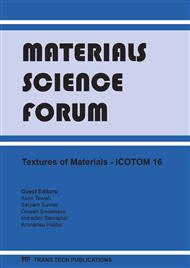p.406
p.411
p.415
p.419
p.427
p.435
p.439
p.443
p.449
On the Impact of Thermo-Mechanical Processing on Texture and the Resultant Anisotropy of Aluminium Sheet
Abstract:
During the thermo-mechanical processing of aluminium sheet products in commercial production lines the material experiences a complex history of temperature, time and strain paths, which result in alternating cycles of deformation and recrystallization with the associated changes in microstructure and, especially, crystallographic texture. Thus, computer-based alloy and process development requires integration of models for simulat¬ing the evolution of microstructure, microchemistry and crystallographic texture into process models of the thermo-mechanical production of Al sheet. In the present paper the influence of texture on the anisotropic properties is explored for various industrially processed aluminium alloy sheets for packaging applications. Besides the use of experimentally measured sheet textures as an input for the anisotropy calculations, particular attention is given to the use of modelled textures. Here, results from a comprehensive through-process modelling of the texture evolution during the thermo-mechanical production of aluminium sheet are utilized. Eventually, this will enable us to predict the evolution of texture and the resulting properties along the entire process chain and hence to improve product quality of aluminium sheet products avoiding laborious and expensive plant trials.
Info:
Periodical:
Pages:
427-434
Citation:
Online since:
December 2011
Authors:
Keywords:
Price:
Сopyright:
© 2012 Trans Tech Publications Ltd. All Rights Reserved
Share:
Citation:


